| |
|
|
|
 |
|
| Welcome
to Game of the Week! Each week there will be a
new featured game on this page. The game may be good,
average or diabolically bad, it really doesn't matter!
Just look at the pics, read the text and enjoy the nostalgia!
:-) Game of the Week! is open to contributions so if you
would like to contribute
a game article for this page you're more than welcome
to! Every article we receive will be considered! |
|
|
Questron
II
1988 Strategic
Simulations Inc. (SSI)
Programmed
by Westwood Associates
|
| |
| Most
text of the present article comes from the review published
in the fortieth issue of the British C64 magazine ZZAP!64
(street date: July 14th, 1988) and the review published
in the forty seventh issue (street date: February 16th,
1989). |
| |
|
In
this month's instalment, our resident generalissimo
casts an expert eye over SSI's Questron
II
and offers some acute hints and tips to those who may
be stuck with it.
.
|
| |
|
|
 |
|
QUESTRON
II
SSI,
£19.99
disk
|
|
|
The
cover of Questron II's box amply prepares the
prospective purchaser for the contents and substance
of the game, if he has any experience at all with SSI's
fantasy roleplaying epics. An impossibly brawny hero
waves a sword at a book floating mystically above eye-level,
while various black-cloaked individuals rage impotently
in the background. This is, as the player may also deduce
from the title itself, a sequel.
"Now
I wonder what you did in Questron I?", I asked
myself as I ripped open the cellophane wrapper with
my battle-sharpened molars. "Saved the Land of Ox from
hordes of ravaging monsters and one particularly nasty
sorcerer with delusions of grandeur?"
I
opened the rulebook and read "Though you have completed
your quest to save the Land of Questron from the crazed
magician Mantor and his Evil Book of Magic..."
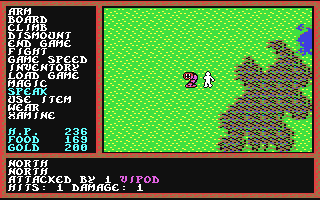
Yes,
it's another half-baked fantasy scenario providing an
excuse to wander around a few mappable dungeons and
wildernesses, hitting monsters over the head and hoarding
treasures. My increasing sarcasm about these plots is
perhaps unfair -- I don't know if I'd be able to come
up with something more original myself in the mushy
fantasy line -- but I can't help feeling that SSI must
employ some talented and imaginative people, and that
this sameness is more the result of laziness than lack
of inspiration. Fantasy roleplaying scenarios of this
type are also characterised by a complete lack of humour,
while they cry out for self-parody; in contrast to Infocom
adventures, for instance, which treat the whole dungeon-prowling
environment with a refreshing pinch of salt.
The
player, as usual, takes on the part of Resident Suicidal
Adventurer (Full-Time). He has just saved the land of
Questron from the yoke of tyranny, but Mesron the Great
Wizard is not satisfied. Mantor's instrument of power
-- the imaginatively-titled Evil Book of Magic -- is
still in existence, and it is apparently flame-proof;
the only way to destroy it is to go back in time and
make sure that it is never created in the first place.
To this end, the adventurer is sent back in time and
space to a place called Landor, a realm ruled by Wise
King Keflar but plagued by the usual prowling monsters
and in danger of insurrection by Mantor and his council
of Six Mad Sorcerers. All advantages that he may have
gained in solving the original Questron are wiped
out, because the character has never existed on Landon;
this may be infuriating for fans of the first game,
but at least it means that players of the sequel are
at no possible disadvantage.
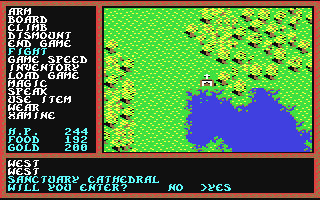
The
packaging is of SSI's usual high quality. There is a
booklet printed on what I think is supposed to be parchment-look
paper, which contains the storyline and a catalogue
of the monsters to be found wandering about the land.
A short description of each adds a bit of colour and
depth to what is just a collection of hit-points when
it's encountered in the game itself. A small card leaflet
disposes of what rules there are with admirable brevity.
This
is not a complex game at all, in terms of rules. It
inclines very much to the minimalist school of computer
roleplaying. The player doesn't even have to roll up
a character: though the character does have the usual
list of attributes like charisma and intelligence, they
are automatically set at a standard level and there
is no opportunity to adjust them. The attributes do
affect things like the probability of hitting in combat
and the damage done, but it's easy to forget they exist
in play. More important and visible are the three simple
status values of hit points, food and gold, which are
displayed permanently on the screen. Every character
starts off with a straight two hundred in each. Hit
points perform the usual function, food is consumed
as the character travels and must not be allowed to
run out, and gold, which is found on monsters and in
treasure chests, can be used to buy weapons, armour,
more food, more hit points and information. Landor is
a very materialist society, even its priests badger
for contributions.
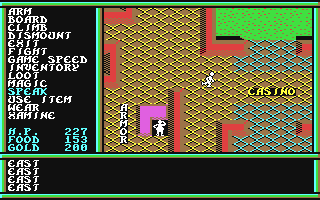
The
player has to prepare a character disk first, which
acts essentially as a save game disk and doesn't take
any time at all to format. Individuality is bestowed
upon characters only by their name. After the bare minimum
of preliminaries, the player's character is launched
into the game and landed - as usual - on the wilderness
map a couple of squares away from a convenient town.
There
is a boating option on the command menu and a section
on sea monsters in the source book, so I gather that
there is more than one land-mass to be explored. The
first 'island' is fairly, though not impossibly, large
and contains plains, forests, swamps and mountain terrain.
Liberally dotted about the landscape are towns, and
there are also a few cathedrals and Castle Redstone,
the abode, by interdimensional video link, of your mentor
Mesron.
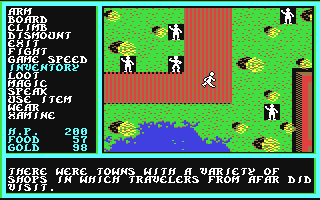
Moving
about the wilderness is an easy matter of guiding the
figure on the screen with the joysticks. The time passes
of its own accord, but not impossibly fast. There seems
to be no seriously noticeable terrain effect, though
as might be expected, the adventurer's journey is frequently
interrupted by random encounters with beasts appropriate
to the environment; different nasties appear on the
mountains and on the plains.
Other
actions are carried out by selecting the appropriate
command on the permanently-displayed menu. The player
can choose to fight, speak, use an item, wear an item
or board a ship. He can examine the attributes and possessions
of his character at any time, and save the game unless
he's down a dungeon (and therefore in real danger).
Manipulating this menu is straightforward enough, though
with the joystick it's slightly clumsy and can lead
to mis-selection in the heat of combat.
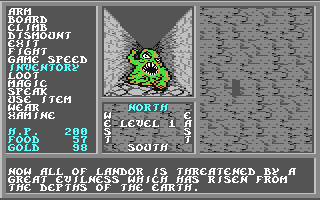
The
towns are laid out very much in the style of Ultima
IV with a variety of shops and characters wandering
about. Not all towns have all facilities, but it's hardly
a long trek between centres of civilisation and most
are well-equipped. The player can buy and sell armour
and arms, stock up on food and hit points, buy pub rumours
for the price of a pint or gamble away some gold on
an interesting selection of games. There's a nicely
presented version of Blackjack and something called
Wizard's Ball which looks like an offcut from some entirely
different game. Gambling is not a very efficient way
to make money in the realm of Landor -- much better
to take a trip out into the country and bash a Snooper
Slink into submission -- but it provides an amusing
diversion for the player. Magic spells are also on sale
in the towns. The character can talk to any of the wandering
inhabitants, but their conversation is very dull and
repetitive. The official rumours are not much better,
and only occasionally amount to more than trite pieces
of advice. At the outset, the variety of weapons and
armour offered is not impressive. It seems that time
has to pass, and the character has to improve, before
the shopkeepers of Landor get more expensive items in.
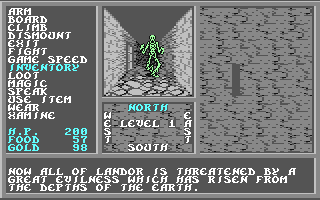
More
exciting than the towns in adventuring terms are the
cathedrals, one of which houses the opening into the
first available tomb and offers the player a chance
at some serious underground adventuring. Tombs are mazes
viewed in the same overhead way as the wilderness, inhabited
by more vicious monsters and containing treasure chests
and characters likely to send you off on the next bit
of your quest. The first place to find is, however,
Castle Redstone. The character is already in possession
of a golden key which opens a door in the castle and
lets him into the Hall of Visions, where Mesron offers
periodic advice from the safe distance of several centuries
into the future. On his first visit, the adventurer
is told to go off and find a magic wand. I assume that
the required wand is hidden somewhere in the tomb, but
despite several forays I haven't managed to stay alive
down there long enough to find it. I have found another
robed gentleman who wishes to be presented with another
magic item before he will help me further, so that must
be the next goal. Perhaps once I've found the wand Mesron
will tell me how to get hold of a boat and sail further
afield . . .
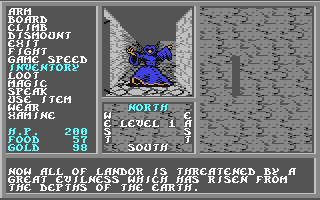
Despite
the unoriginality of the concept and the implementation,
Questron II is a great deal of fun to play and
this 'interlocking quest' kind of storyline is enough
to sustain interest. There does seem to be a definitive
narrative game structure, with the enticing promise
of something different if you persist. There is, for
instance, a whole aspect of the game that I cannot comment
upon because I didn't get that far; the real dungeons,
as opposed to the tombs, are displayed in animated 3D
perspective. How well this works I can't say, because
I suspect that the first dungeon lies overseas and despite
several hours of play I hadn't even succeeded in finding
the first magic artifact. I would have been happy to
carry on if I hadn't had to tear myself away to write
the review itself.
The
complexity of the storyline amply makes up for the simplicity
of the play. Many players will, indeed, consider the
lack of statistics and complex combat to be an advantage.
Questron II is worth looking at.

|
| |
|
Despite
the unoriginality of the concept and the implementation,
Questron II is a great deal of fun to play
and this 'interlocking quest' kind of storyline
is enough to sustain interest. There does seem
to be a definitive narrative game structure, with
the enticing promise of something different if
you persist. There is, for instance, a whole aspect
of the game that I cannot comment upon because
I didn't get that far; the real dungeons, as opposed
to the tombs, are displayed in animated 3D perspective.
How well this works I can't say, because I suspect
that the first dungeon lies overseas and despite
several hours of play I hadn't even succeeded
in finding the first magic artifact. I would have
been happy to carry on if I hadn't had to tear
myself away to write the review itself.
The
complexity of the storyline amply makes up for
the simplicity of the play. Many players will,
indeed, consider the lack of statistics and complex
combat to be an advantage. Questron II
is worth looking at.
|
|
|
Presentation 76%
Well
packaged and easy to operate.
Graphics
72%
Respectable,
given the type of game it is -- the graphics of
the player character and monsters on the overhead
view are rather small and indistinct.
Rules
66%
Judged by the usual standards of
the company, not very full.
Playability
87%
The simple play keeps the action
smooth and fast, and the interlocking storyline
is compelling.
Overall
81%
An entertaining example of its
type, though not the best available.
.
|
|
|
| |
|
TACTICS
This
month Tactics concentrates on advice for those who wish
to venture forth into the world of Questron II,
reviewed in this issue. A computer, a joystick and a
good deal of suspended disbelief are essential items
of equipment. And so is a properly documented, unpirated
copy of the game itself; there are periodic checks to
see if you possess a copy of the instruction manual!
The
first island is not too big, and it's easy enough to
make a rough map as you explore. The only features worth
marking are towns, cathedrals and the castle. From a
vague shape it's easy to navigate -- it might be a good
idea to make a note of which towns offer what facilities.
It's
a good idea to upgrade your armour and weapons as soon
as you can afford it. Buy rawhide armour first of all,
and don't forget to wear it; the better weapons and
armour won't be offered for sale until a little time
has passed, but when they are, a staff will inflict
satisfyingly large amounts of damage on wilderness and
tomb monsters alike, and ring mail offers reasonable
protection.
Your
first destination is Castle Redstone, which is located
on the southwest of the map. One of the locked rooms
there will open, if you use the golden key you have
in your inventory at the start of the game, and turns
out to be the Hall of Visions. This is Mesron's interdimensional
video link, and once you get there he will send you
on your quest and give you some attribute boosts into
the bargain.
The
second place to head for is Rivercrest Cathedral, which
is inconveniently situated behind a mountain range on
the northwest corner of the island. To get to it you
need to buy climbing equipment, available at several
towns in the Travel shops. This cathedral houses the
entrance to Rivercrest Tomb.
To
loot chests, stand in front of them and choose the 'loot'
option from the menu; but be very wary of doing this
in cathedrals or in Castle Redstone! You bring down
the wrath of every guard in the building, and I've never
managed to escape alive after such a raid. Chests in
the tomb, on the other hand, are there to be robbed.
Tackle
the tomb in several forays, stocking up on hit points
between each and saving the game before entering the
cathedral. The moonstone amulet provided you with food,
and sooner or later you should find a copper key which
unlocks some more of the doors in Castle Redstone.
Beyond
the 'copper' doors in Castle Redstone you can pay 1000
gold pieces to buy some maps. But keep a pen and paper
ready; you don't get to keep them, only to look at them!
.
|
 |
|
QUESTRON II
SSI/US
Gold, Amiga £24.99
|
| |
|

|
ell,
spit in my billy-goat's eye if this isn't another
RPG that's been around on the 64 for a mega long
time. That hard-hatted Philippa woman gave it
81% last summer, probably just around the time
when six gnomes on their way to a garden convention
decided to shelter under my bridge. Dead good
banquet, that.
|
|
|
Er . . . yeah, right. Let's do a recap of what this
here story's all about. Back in the good old days when
evil was allowed to run unchecked in Landor, six mad
sorcerers got together to produce a very nasty book
-- a magic book, to be precise. All you have to do is
go back in time and make sure it's never created. Easy,
eh?
The
action is displayed with full overhead view pretty much
Ultima-style except that you only ever control
one character and all your options (fight, climb, use
magic, loot, wear etc) are always displayed on screen.
Basically, you leg it round a countryside of swamps,
forests and mountains, bashing some pretty ugly monsters
(vipods, mutant carps, stink worms, jelly nymphs) and
looking for food. Towns (where you can gamble, buy food,
spells and a whole load of other gadgi items), cathedrals,
tombs and 3D dungeons are dotted around the place --
but your main, well-hard, mega-objective is to get to
the Hall of Visions for a bit of advice.
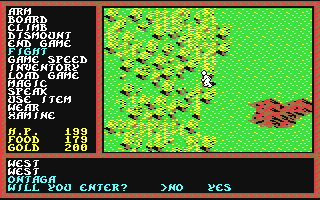
Well
-- would you enter that place? Not even a
tough old troll like me goes in unarmed...
Easier
said than done, that. For a start, you haven't got a
map (though it's not difficult to make your own) and
worse still, it's pretty hard going if you try and fight
everything right from the word go. The more puzzles
you solve, the higher your character rating, the more
advanced magic, weapons (fancy things like a fauchard,
whatever that is) and means of transport (llama, ships,
eagle) you can buy. Trouble is, you may not survive
that long. Your best plan (apart from to stop for a
slime-break and a fried lizard leg) is to suss out which
creatures are easy to kill and get the hell out of it
when any others appear. Oh yeah -- and buying information
out of the odd helpful, friendly troll might do you
a bit of good. After some of the portrayals of trolls
we've had in recent games, I'm pretty chuffed at these;
they even got the colour right -- a very fetching shade
of green. Luverly.
Whaddya
think of it so far then? Sounds pretty much like Ultima
IV. Not exactly, Ashley (he's my pet fly). For a
start, the fighting and speaking options are pretty
limited (just bash and listen) and they could have included
at least a basic map. I could have tangoed to a bit
more sound as well. Minimal spot effects aren't much
when you've got all those bits of wire soldered together
inside the Amiga just so you can have loadsa notes.
Still,
the graphics aren't 'arf bad for an RPG and all that
bashing, munching and trading does get pretty addictive
-- especially if you cheat (I did hur, hur, take a look
at the Vale Of Hope). Once you've got into the puzzles
(which might take up an afternoon's lizard hunt), it
really starts to get froody. OK, so it is not the most
involved RPG you've ever seen, but it is good fun. And
I can tell you, after a week of bile and stomach bug
down under Ludlow Bridge, you can forget about gnome
pavlova, billy-goat pie and lizard stew -- it's fun
that really counts. Er... burp...
|
| |
| Atmosphere |
80% |
| Puzzle
Factor |
70% |
| Interaction |
59% |
| Lastability |
93% |
|
Overall
|
80% |
|
| |
 |
|
Htmlized
by Dimitris
Kiminas (19 Aug 2006)
There were no screenshots in the original C64 review.
The single screenshot in the original Amiga review has
been replaced with its equivalent from the C64 version.
Other
"Games of the Week!"
Home
|
| |
|
|
|